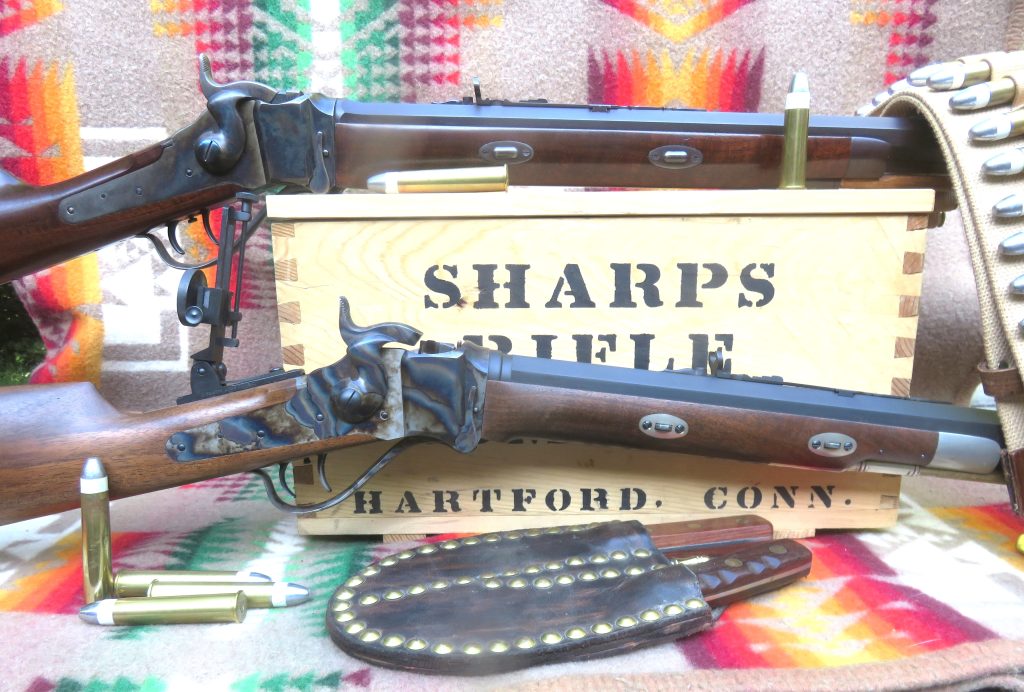
By Mike Nesbitt
A “Gemmer,” in today’s Sharps-lingo, is a Sharps rifle or carbine that has been customized and rebuilt by J. P. Gemmer, the man who had worked for Sam Hawken in the St. Louis shop and then took it over when Hawken retired.
In a way, the Gemmer/Sharps rifles might be on the mythical side because no originals of such guns have surfaced as yet to the best of my knowledge. However, Gemmer did customize and rebuild a number of Spencer rifles which gave those guns the look of a Hawken plains rifle. And, because Gemmer had bought the stamps when he bought the Hawken shop, some of those Gemmer/Spencer rifles were marked with “S. Hawken” on their barrels.
Other gunsmiths did modify the Sharps rifles, giving them forearms that were attached to the barrels with keys or wedges. Those rifles were often fitted with under the barrel ramrods as well. Henry Slotterbek, in Los Angeles, was one of those ‘smiths. But such rifles did not have the “Hawken look” which the Gemmer/Spencer rifles certainly did.
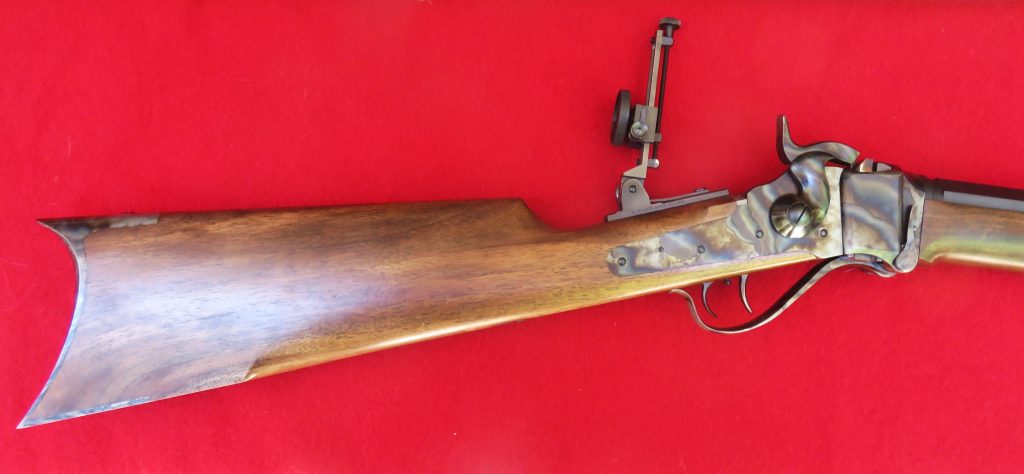
It was the Gemmer/Spencer versions, I believe, that led the way to the Gemmer/Sharps rifles of today and those guns are certainly worth taking a good look at, especially if you are a fan of the “mountain man” percussion Hawken rifles. That was fueled by the famous painting done by Ralph Heinz called “The Scout and the Tenderfoot” which became a trade mark, so to speak, for C. Sharps Arms with that image on their belt buckles and bolo ties. In that painting, and frameable prints are still available from C. Sharps Arms (info@csharpsarms.com), the scout is packin’ a paper cartridge Model 1863 Gemmer/Sharps with percussion ignition while the tenderfoot cradles a centerfire cartridge-firing ’74 sporting rifle in the cross-sticks.
My chance to shoot a percussion Gemmer/Sharps by C. Sharps Arms came just forty-five years ago and that convinced me that I had to have one but I wanted a centerfire Model 1874 version. So, C. Sharps was contacted and I was told that a .50-90 was just about finished. Fitting my “busy schedule” to a T, I put my name on it.
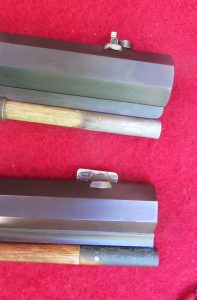
That was my first Sharps rifle. When I went to Richland, Washington, where C. Sharps Arms was located at that time, John Schoffstall made sure I got everything with the gun. The armful of plunder which was bought along with the rifle included reloading dies, case trim die, an RCBS bullet mold, bullet sizing die, one box of loaded ammo plus another box of brass, and even included a copy of the rather new book (at that time) Sharps Firearms by Frank Sellers. I was even taken to a rifle range by one of the workers at C. Sharps Arms so he could help me sight the rifle in.
At that time, I was GUNS magazine’s Black Powder Editor and I let John at C. Sharps know that a deer hunt was waiting for me. That might have been why they were so helpful in making sure that I had ammo and reloading tools. I do recall that pictures of my visit to the shop to get the gun, sighting it in, and “making meat” on the hunt were all on the same roll of film. A doe was taken for meat with that .50-90 using a full 90-grain load, yes, that was “enough gun” and my story about using the Gemmer/Sharps, titled “Mountain Man’s Breechloader” on that hunt was published in GUNS magazine’s May issue, 1981.
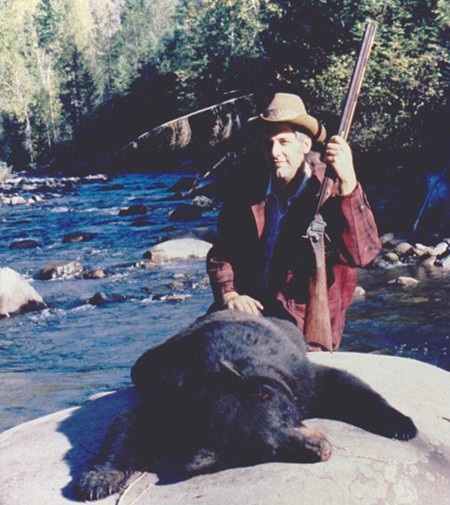
Another hunt was made in 1981 where I took a medium sized black bear with the .50-90 while using paper patched bullets. My Gemmer/Sharps was mainly a hunting rifle. As a hunting rifle, it was a good one and it was always used with the buckhorn and blade sights. It is actually very light for a .50-90 with its standard weight barrel. That rifle weighs only 9 pounds, which made it handy for hunting. And while shooting at game, the heavy recoil of the “Big .50 was never noticed but it certainly would be while shooting at targets or in matches.
But that rifle is a beauty. It never fails to draw interest from other shooters wherever I take it. While I haven’t seen any of the records from C. Sharps Arms during their days in Richland, my .50-90 might be the first Model 1874 Gemmer/Sharps they made. It is certainly an early one and it still used the lock from the percussion model rifles, with the very high position of the hammer at half-cock which made it easy for putting the caps on the nipple.
That was when C. Sharps Arms built their rifles on Shiloh actions. My rifle, like at least a few others, is not marked with “C. Sharps Arms” on the barrel but it does carry the “Old Reliable” stamp which is a trade mark of C. Sharps Arms. In fact, the C. Sharps Arms stamp and address might be on the barrel under the long buckhorn sight, I’ve never looked. Because of the name on the side of the action, “Shiloh Rifle Manufacturing Company, Farmingdale, NY,” several times the Gemmer/Sharps versions are referred to as being made by Shiloh but they were all made, as far as I know, by C. Sharps Arms. And let’s remember, the Gemmer/Sharps rifles were all custom ordered and during their partnership, in Big Timber, which lasted until about 1990, C. Sharps Arms was the custom shop for Shiloh.
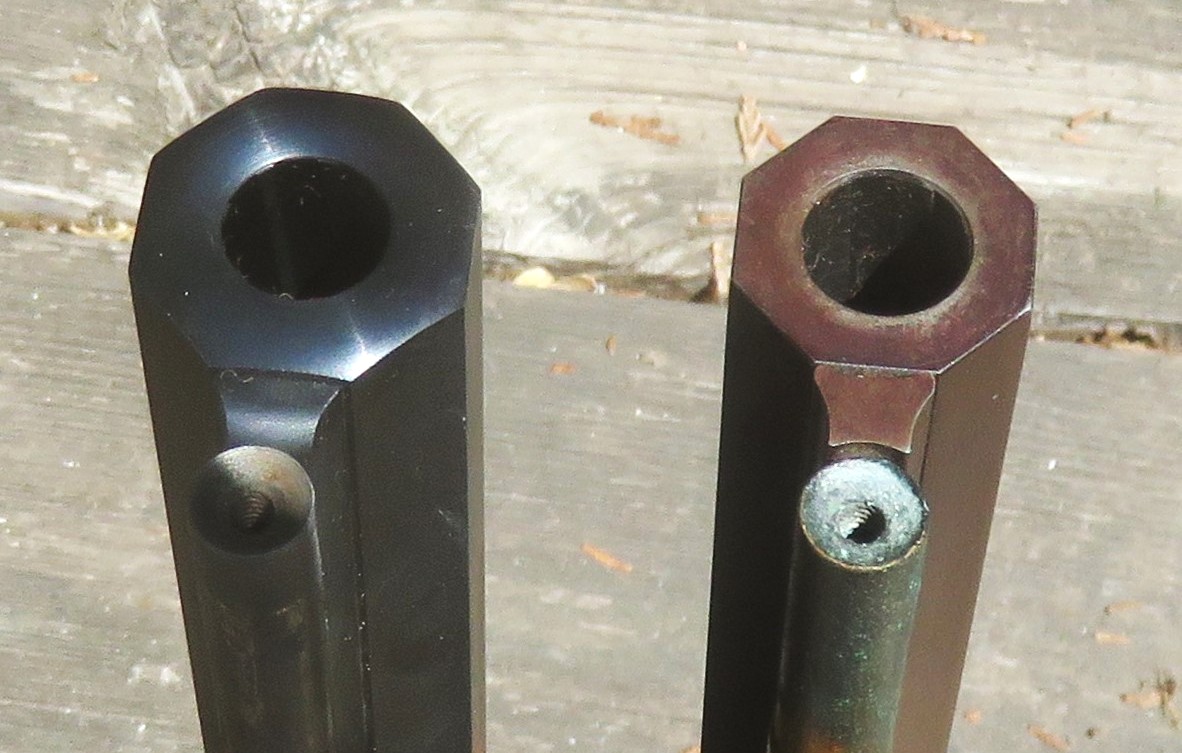
Unlike most rifles made by C. Sharps Arms, this gun’s barrel and furniture wear a browned finish instead of being blued. The action and the lock, including the breech block, are color casehardened. In my opinion, this is certainly a very beautiful rifle.
While I used it primarily as a hunting rifle, I did feel that the .50-90 caliber was on the “strong side” of what I might actually need. That made me wish, sometimes strongly, that it was chambered in .50-70 caliber instead. Having it in .50-70 caliber would make it more comfortable to shoot and, therefore, allow more recreational shooting to be done with it. Re-barreling this rifle was considered but now I’m just as happy that it still remains a .50-90.
Years rolled by until 2017 when a fellow Sharps fan contacted me. That was Del Slaugh, living in Colorado, and he was going to order another Sharps rifle but hadn’t made up his mind about what to get. After talking a while, by e-mail, I suggested that he get a .50-70. He didn’t already have a Sharps in that caliber, so a .50-70 it would be. Then he considered what style of Sharps he would want and I asked him if he had a Gemmer. No, he didn’t. And that became his decision, a Gemmer/Sharps in .50-70 by C. Sharps Arms.
A few complications arose when he placed that order because C. Sharps Arms had not made a Gemmer for a matter of years, which means they didn’t have any of the necessary parts on hand. The butt stock and butt plate were used from their “1874 Sharps Semi Custom Classic Hartford Sporting Rifle” (which is no longer made) and that gun’s crescent butt plate looks like it fits right in. The same can be said about the “beavertail” cheek piece on the left side of the stock. And while the butt plate on my Gemmer is browned, the steel butt plate on the .50-70 was color casehardened which, I have to say, really sets it off.
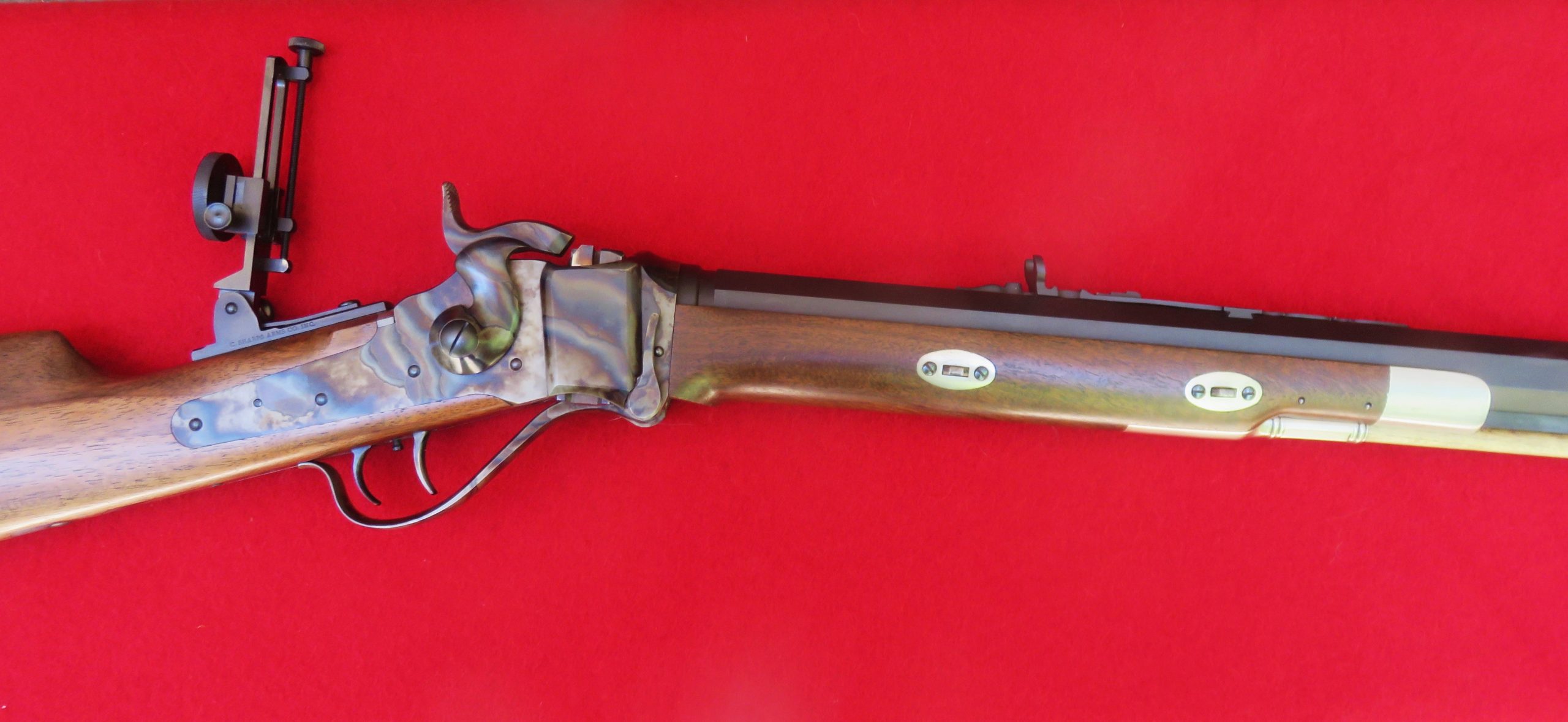
Unlike my .50-90 Gemmer, this .50-70 was made with a #1 Heavy barrel, 30 inches long, which is highlighted with the Hartford collar. That gives this rifle a weight of 12 ½ pounds. Held to the barrel with the twin wedges or barrel keys, the forearm is capped with a poured pewter nose cap instead of the browned steel cap which my earlier gun has. Also, the escutcheons surrounding those wedges are nickel silver in color while on the .50-90 those pieces are browned. Having the silver escutcheon and nose cap certainly add some good color to the rifle.
Instead of a blade front sight, Del selected a Beach sight from Montana Vintage Arms. That gives the shooter a choice of a short “blade” or a beaded post within a circle, which can make that sight a good choice for hunting and for targets. The long “Hawken” rear sight is on the barrel, in a dovetail, and he also had a mid-range deluxe Vernier sight added to the gun.
The total picture really makes a beautiful rifle. Those special features were wrapped in the straight grained walnut which seems to tell how the gun was made to be shot and maybe hunted with. I do believe that was in Del’s interest and intensions for getting this rifle.
We remained in contact and made plans, for three years in a row, of how we could meet at the big “Matthew Quigley Buffalo Rifle Match” and take a picture with our two .50 caliber Gemmer-styled Sharps rifle together. But that never happened and I never got to meet Del…
Del had a bad and sneaky cancer get the best of him and he passed on in 2022. In time I was contacted by his son, with questions about those Sharps rifles. Without being too hesitant, my desires to have that .50-70 Gemmer were made known to him and just recently that Gemmer became mine.
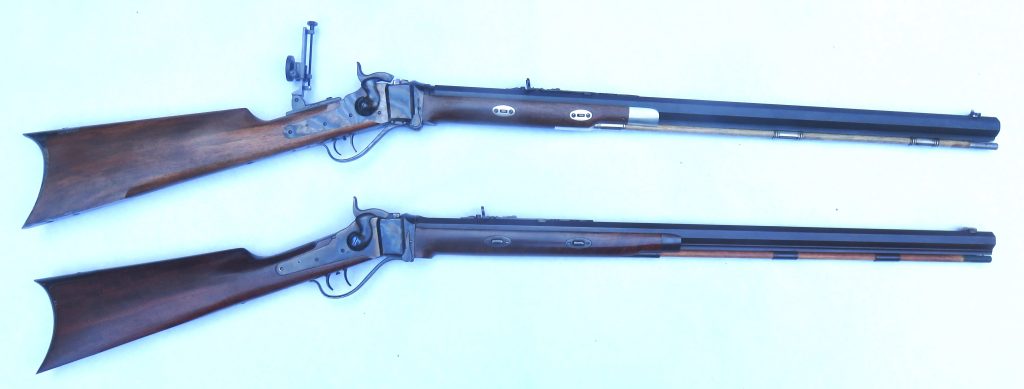
This .50-70 really is an outstanding rifle. I’ve already mentioned how my .50-90 Gemmer might be the first centerfire metallic cartridge-firing Gemmer that C. Sharps Arms made, during their early years. While that is a good possibility, it is a fact that the .50-70 “Del Slaugh Gemmer” is the last Gemmer-styled Sharps made by C. Sharps Arms. This could make those two rifles “the first and the last.”
Finally, I’m able to photograph the two rifles together.
Probably, I’ll never know if Del fired his .50-70 Gemmer, although I might comb through my old notes from him to look for a clue. When I got the gun, it looked unfired. And it was not sighted-in. Testimony to that came from a trip to the range where it was discovered that the sights still needed to be set in order to hit the target. But this gun now hits the target quite nicely and it is much more pleasant to shoot than its earlier counterpart in .50-90 caliber.
For now, I’ll just keep these two Gemmer/Sharps rifles together. They’re a good pair. Whether I shoot either one of them again simply remains to be seen. I have nothing against shooting them but I do have other rifles that can easily draw my attention, especially another Sharps in .50-70. In addition to that, Del’s son is remaining in contact and he has let me know how he wants first crack at it should I decide to part with the Del Slaugh Gemmer. Of course, Del’s son will be the first to know.



